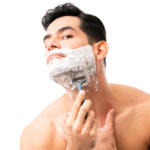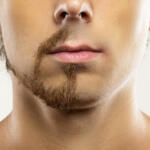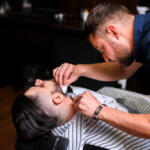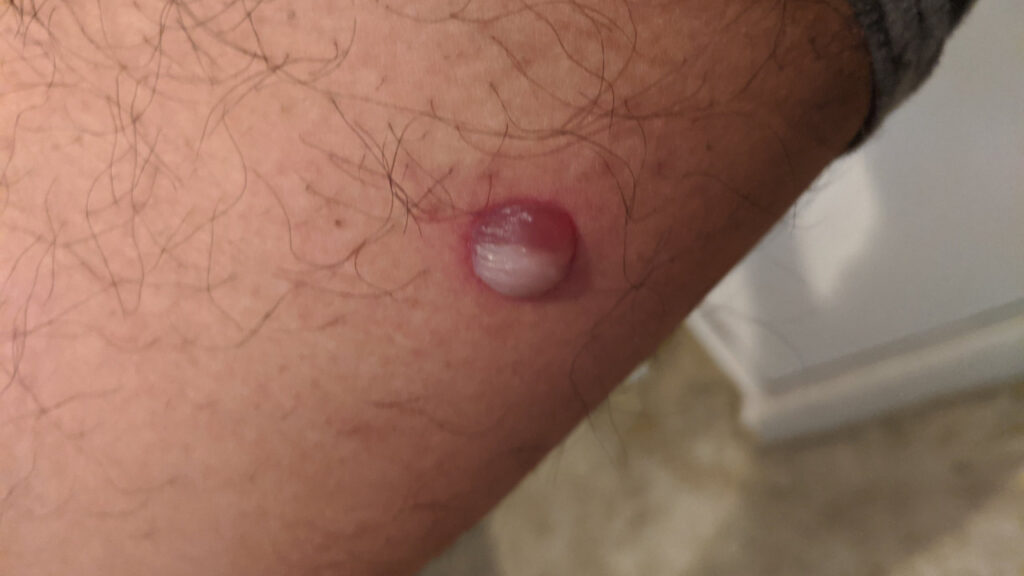
Are you noticing a bad smell coming from ingrown hair? If so, you’re not alone. While it can be embarrassing, it’s a common issue for people who experience ingrown hairs.
Table Of Contents
−- Introduction to Ingrown Hairs
- What Causes the Smell Associated with an Ingrown Hair?
- What Causes Ingrown Hairs?
- What Does an Ingrown Hair Look Like?
- How to Prevent Ingrown Hairs
- How to Treat an Infected Ingrown Hair
- What is Hidradenitis Suppurativa, and How Does it Smell?
- What are the Symptoms of Hidradenitis Suppurativa?
- Treating Hidradenitis Suppurativa
- Conclusion
In this post, we’ll discuss why your ingrown hair might be causing an odor and what you can do about it.
Introduction to Ingrown Hairs
Ingrown hairs are a common skin condition that occurs when a hair curls and grows back into the skin instead of growing outwards. They can be red, painful, and filled with pus. They often occur on the face, neck, pubic area, and other areas where hair is removed.
Ingrown hairs can cause red, itchy bumps on the skin’s surface and mostly go away in several days or weeks. In some cases, ingrown hair in the pubic area or underarm can develop into a cyst, a large, painful bump. Knowing what causes ingrown hairs and how to prevent them is key to avoiding an uncomfortable experience.
What Causes the Smell Associated with an Ingrown Hair?
Ingrown hairs can be uncomfortable and unpleasant, but an unpleasant smell can also accompany them. This is due to the bacteria that can sometimes cause infection in the ingrown hair area.
The bacteria produce a type of pus with odor, and the smell can increase when the area is inflamed or broken; in some cases, this smell may also be associated with hidradenitis suppurative, a chronic skin condition characterized by painful lumps or boils in areas such as armpits, groin, and buttocks.
The smell comes from the content of the cysts or boils that form due to the condition. To reduce the odor associated with ingrown hairs, avoiding soaps and other products with harsh chemicals or ingredients that can irritate the skin is important.
It is also important to seek medical attention if an infection develops, as antibiotics may be necessary to treat it.
What Causes Ingrown Hairs?
Ingrown hairs are caused when hair follicles become clogged with dead skin cells, oil, and bacteria. This causes the hair to grow sideways instead of up and out of the skin. This can happen due to shaving, waxing, tweezing, or using an epilator. Ingrown hairs can also be genetic in some cases.
People with curly or coarse hair are more prone to developing ingrown hair due to the shape of their hair follicles. Additionally, conditions such as psoriasis and eczema can make the skin more prone to developing ingrown hairs.
What Does an Ingrown Hair Look Like?
An ingrown hair typically looks like a pimple in the skin, with a red bump that can become swollen, itchy, and painful. In some cases, you may see the hair trapped beneath the skin. The area around the ingrown hair may become infected with Staphylococcus aureus, presenting with itchy bumps, pain, flushed skin, and pus.
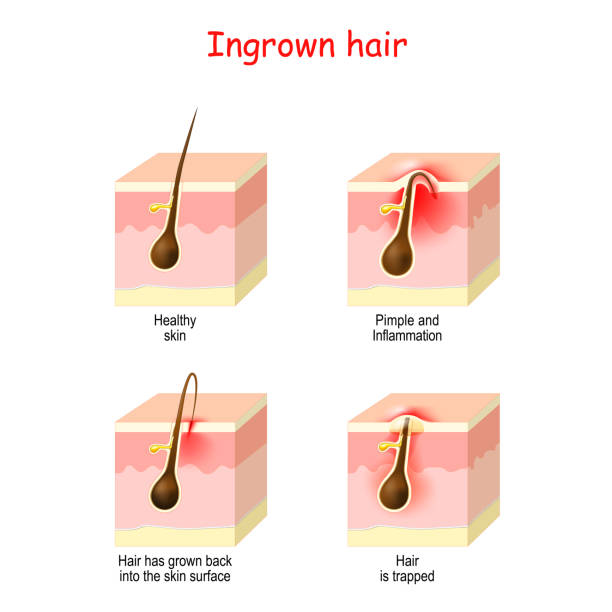
It’s important to take note that each body has a different reaction to ingrown hairs and of to any changes in the area and seek medical attention if necessary. In some cases, an infection can be treated with antibiotics, and any skin irritation can be soothed with warm compresses. Prevention is key to avoiding ingrown hairs, so practicing proper skincare techniques is essential.
How to Prevent Ingrown Hairs
Preventing ingrown hairs is the best way to avoid their uncomfortable symptoms. You can read our full ingrown prevention guide or continue for our summarized version here.
The most effective way to prevent ingrown hairs is to exfoliate regularly. It helps remove dead skin cells, which can clog pores, allowing hairs to grow inwards instead of outwards.
Additionally, it is beneficial to shave in the direction of hair growth and use a sharp razor blade. It’s also important to moisturize after shaving, as this can reduce the risk of irritation and inflammation. Finally, avoid tight clothing that could rub against hair follicles and cause irritation. These tips can help prevent pesky ingrown hairs from ruining your day!
How to Treat an Infected Ingrown Hair
While treating minor ingrown hair can be done at home, treating an infected ingrown hair can be tricky. If you believe the area is infected, you must visit your doctor or dermatologist. They can assess the area and advise you on the best action, including medications to reduce pain and swelling or antibiotics to treat the infection.
In addition, you may need to use soothing serums to reduce inflammation and discomfort and gently exfoliate the skin. To help reduce irritation and itching, keep the area clean and dry, and avoid picking or squeezing the ingrown hair. If left untreated, an infected ingrown hair can lead to more serious complications such as cysts or scarring.
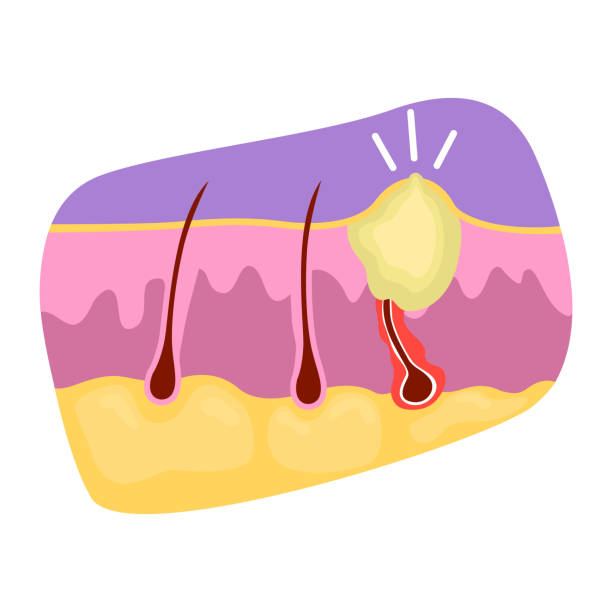
What is Hidradenitis Suppurativa, and How Does it Smell?
Hidradenitis suppurative (HS) is a chronic skin condition characterized by painful, inflamed, and smelly lumps. It is caused by an obstruction of the sweat glands, which leads to the glands becoming infected and filled with fluid.
The infection then spreads and causes larger areas of swelling, which can ooze pus with a bad smell. This odor is usually caused by the mixture of sweat, bacteria, and skin tissues that are infected and inflamed.
To prevent HS, it is important to keep the skin clean and avoid tight clothing that can irritate the skin and cause lesions to rupture sooner. If you believe you have HS, you must consult your healthcare provider for an accurate diagnosis and treatment plan.
What are the Symptoms of Hidradenitis Suppurativa?
The symptoms of Hidradenitis Suppurativa (HS) can vary depending on the severity of the condition. Common symptoms include deep, painful boils or pockets of infection (abscesses) in the skin, which can break open, and ooze pus with a foul smell.
Sinus tracts may also form between the abscesses and the skin’s surface. In addition to pain and smell, HS can lead to itching, burning, and swelling in the affected area. If left untreated, HS can cause scarring and even permanent hair loss. It is important to visit a doctor for diagnosis and treatment if you experience any of these symptoms.
Treating Hidradenitis Suppurativa
Treating Hidradenitis Suppurativa (HS) requires medical intervention. A dermatologist is the best person to talk to about treatment options for HS, as they specialize in diagnosing and treating skin conditions.
Many possible treatments are available, including antibiotics and other medications, topical creams and ointments, and surgery. In some cases, lifestyle changes such as weight loss, improved hygiene, and stress management can also help reduce the frequency of HS outbreaks.
Working closely with your doctor to find a treatment plan that works best for you is important.
Conclusion
In conclusion, ingrown hairs can be a nuisance and cause various symptoms, including an unpleasant smell. It is important to seek medical attention if you believe you may have an infection or if your symptoms persist.
Prevention is key in avoiding ingrown hairs, as is proper hair removal technique and gentle daily skin care. Hidradenitis Suppurativa, though rare, is a more serious condition that may require medical attention. If you suspect, you may have this condition, please reach out to your healthcare provider for further instruction.
Last update on 2024-04-26 / Affiliate links / Images from Amazon Product Advertising API
Affiliate Disclosure: This post contains affiliate links, which means I may receive a small commission, at no extra cost to you, if you make a purchase using these links.

Jay Kang
Just because i'm asian does not mean I don't need shaving. I always wanted to grow a beard when I was young, now I need to shave because hair growth for me is a problem. I'm going through what every man will and has gone through before.

